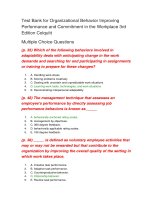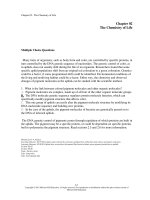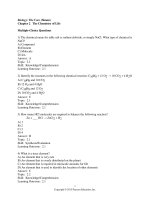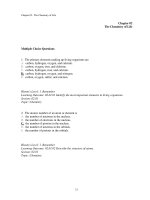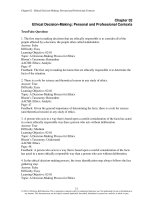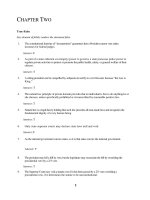Organizational behavior improving performance and commitment in the workplace 3rd edition colquitt test bank
Bạn đang xem bản rút gọn của tài liệu. Xem và tải ngay bản đầy đủ của tài liệu tại đây (485.27 KB, 139 trang )
Chapter 02
Job Performance
True / False Questions
1. Evaluating an employee's performance based on results alone gives an accurate
picture of which employees are worth more to the organization.
True
False
2. Job performance is formally defined as the value of the set of employee behaviors
that contribute, either positively or negatively, to organizational goal
accomplishment.
True
False
3. Task performance includes employee behaviors that are directly involved in the
transformation of organizational resources into the goods or services that the
organization produces.
True
False
4. Task performance is the set of explicit obligations that an employee must fulfill to
receive compensation and continued employment.
True
False
5. Routine task performance involves employee responses to task demands that are
novel, unusual, or, at the very least, unpredictable.
True
False
6. Adaptive task performance involves employee responses to task demands that are
novel, unusual, or, at the very least, unpredictable.
True
False
7. Creative task performance is the degree to which individuals develop ideas or
physical outcomes that are both novel and useful.
True
False
8. Creative task performance is an expected behavior limited to jobs such as artist
and inventor.
True
False
9. The first step in conducting a job analysis is to generate a list of all the activities
involved in a job.
True
False
10. The O*NET is an online government database that describes the results of task
performance behaviors that must be reported by firms to the government on an
annual basis.
True
False
11. O*NET captures the "numerous small decisions" that separate the most effective
organizations from their competitors.
True
False
12. The most valuable employees in any organization are those who take extra efforts
and perform tasks that were previously unheard of.
True
False
13. Citizenship behavior is defined as voluntary employee activities that may or may
not be rewarded.
True
False
14. Courtesy refers to keeping coworkers informed about matters that are relevant to
them.
True
False
15. Sportsmanship involves maintaining a good attitude with coworkers, even when
they've done something annoying or when the unit is going through tough times.
True
False
16. Interpersonal citizenship behavior is not important when employees work in small
groups or teams.
True
False
17. Organizational citizenship behaviors benefit the larger organization by supporting
and defending the company, working to improve its operations, and being
especially loyal to it.
True
False
18. Boosterism involves speaking up and offering constructive suggestions for
change.
True
False
19. Counterproductive behavior is defined as employee behaviors that unintentionally
hinder organizational goal accomplishment.
True
False
20. Property deviance refers to behaviors that harm the organization's assets and
possessions.
True
False
21. Wasting resources is the most common form of production deviance.
True
False
22. Substance abuse is a form of political deviance.
True
False
23. Political deviance refers to behaviors that intentionally harm the organization's
assets and possessions.
True
False
24. Gossiping represents communication that is rude, impolite, discourteous, and
lacking in good manners.
True
False
25. Personal aggression is defined as hostile verbal and physical actions directed
toward other employees.
True
False
26. People who engage in one form of counterproductive behavior do not usually
engage in other forms.
True
False
27. Sometimes the best task performers are also the employees who engage in
counterproductive behavior.
True
False
28. There is a positive correlation between task performance and counterproductive
behavior.
True
False
29. In addition to being more cognitive, knowledge work tends to be more structured
and static in nature.
True
False
30. Service work involves direct verbal or physical interactions with customers.
True
False
31. Service work contexts place a greater premium on high levels of citizenship
behavior and low levels of counterproductive behavior.
True
False
32. The MBO approach involves collecting performance information not just from the
supervisor but from anyone else who might have firsthand knowledge about the
employee's performance behaviors.
True
False
33. BARS emphasizes the results of job performance as much as it does the
performance behaviors themselves.
True
False
34. Feedback from BARS can help an employee develop and improve over time.
True
False
35. Very few 360 degree feedback systems ask the employee to provide ratings of
his/her own performance.
True
False
36. Despite its popularity, 360 degree feedback is not well suited for developing
employee talent.
True
False
37. According to Jack Welch's "vitality curve," the employees are segregated into the
top 30 percent, the vital middle 60 percent and the bottom 10 percent
True
False
38. According to Welch, C players are the backbone of the company but lack the
passion of the A players.
True
False
39. Social networking sites and their applications can be used to monitor employee
performance.
True
False
Multiple Choice Questions
40. The value of the set of employee behaviors that contribute, either positively or
negatively, to organizational goal accomplishment is known as _____.
A. task identity
B. task orientation
C. job satisfaction
D. job performance
E. organizational commitment
41. _____ includes employee behaviors that are directly involved in the transformation
of organizational resources into the goods or services that the organization
produces.
A. Task performance
B. Citizenship behavior
C. Counterproductive behavior
D. Job orientation
E. Organizational commitment
42. The explicit obligations that an employee must fulfill to receive compensation and
continued employment are referred to as _____.
A. job orientation
B. citizenship behavior
C. organizational commitment
D. task performance
E. counterproductive behavior
43. Charles finds an advertisement for an accountant's position at a local office. The
advertisement mentions preparing, examining, and analyzing accounting records
for accuracy and completeness as job responsibilities of the accountant's position.
These job descriptions typically refer to:
A. comprehension skills.
B. task performance.
C. counterproductive behavior.
D. citizenship behaviors.
E. organizational commitment.
44. _____ involves well-known responses to normal job demands that occur in a
predictable way.
A. Job enhancement
B. Adaptive task performance
C. Counterproductive behavior
D. Routine task performance
E. Citizenship behavior
45. Paul, a ticket collector, performs his duty robotically every day. This refers to:
_____.
A. sportsmanship
B. adaptive task performance
C. routine task performance
D. counterproductive behavior
E. citizenship behavior
46. _____ involves employee responses to job demands that are novel, unusual, or
unpredictable.
A. Job dissonance
B. Adaptive task performance
C. Counterproductive behavior
D. Routine task performance
E. Citizenship behavior
47. For a kindergarten teacher, assisting her students out of a smoke-filled elementary
school is an example of _____.
A. citizenship behavior
B. routine task performance
C. job dissonance
D. counterproductive behavior
E. adaptive task performance
48. Adaptability involves all of the following EXCEPT:
A. handling work stress.
B. solving problems creatively.
C. handling emergencies.
D. performing daily routine work.
E. responding to unpredictable demands.
49. Which of the following behaviors involved in adaptability deals with anticipating
change in the work demands and searching for and participating in assignments
or training to prepare for these changes?
A. Handling work stress
B. Solving problems creatively
C. Dealing with uncertain and unpredictable work situations
D. Learning work tasks, technologies, and work situations
E. Demonstrating interpersonal adaptability
50. Riya has become famous creating new styles in women's formal wear. Her
assistants copy the patterns created by Riya, cut cloth pieces and sew them into
garments that look like Riya's creations. The work done by Riya is a type of _____
whereas the work done by her assistants is a type of _____.
A. routine task performance; creative task performance
B. creative task performance; counterproductive behavior
C. citizenship behaviors; counterproductive behavior
D. counterproductive behavior; creative task performance
E. creative task performance; routine task performance
51. Which of the following is wrong about job analysis?
A. The first step in job analysis is to generate a list of all job activities.
B. A subject matter expert is consulted regarding the frequency and importance of
all job activities.
C. Each activity is rated by subject matter experts, according to things like
importance and frequency of the activity.
D. Activities with the lowest ratings are used to define job responsibilities.
E. Job analysis is used by many organizations to identify task performance
behaviors.
52. The electronic government database used to identify the set of behaviors needed
to define task performance is known as the:
A. behaviorally anchored ratings scale network.
B. employment analysis network.
C. occupational information network.
D. task performance analysis network.
E. job responsibilities network.
53. Which of the following statements about the O*NET is false?
A. It captures the "numerous small decisions" that separate the most effective
organizations from their competitors.
B. It is an online database.
C. It is involved in figuring out the important tasks for a given job.
D. It includes the characteristics of most jobs in terms of tasks.
E. It includes the required knowledge, skills, and abilities to perform a task.
54. _____ is defined as voluntary employee activities that may or may not be rewarded
but that contribute to the organization by improving the overall quality of the
setting in which work takes place.
A. Creative task performance.
B. Adaptive task performance.
C. Counterproductive behavior.
D. Citizenship behavior.
E. Routine task performance.
55. Citizenship behaviors can be divided into the two main categories of:
A. intrapersonal and organizational.
B. interpersonal and intrapersonal.
C. organizational and political.
D. interpersonal and political.
E. interpersonal and organizational.
56. Which of the following behaviors benefits coworkers and colleagues and involves
assisting, supporting, and developing other organizational members in a way that
goes beyond normal job expectations?
A. Intrapersonal citizenship behavior
B. Interpersonal citizenship behavior
C. Organizational citizenship behavior
D. Production citizenship behavior
E. Political citizenship behavior
57. Interpersonal citizenship behaviors consist of all the following EXCEPT:
A. helping.
B. courtesy.
C. sportsmanship.
D. boosterism.
E. respect for others.
58. Interpersonal citizenship behavior includes:
A. voice.
B. civic virtue.
C. sportsmanship.
D. boosterism.
E. secrecy.
59. Don always maintains a good attitude with coworkers even when the department
goes through tough times. Don's behavior is an example of:
A. helping.
B. courtesy.
C. sportsmanship.
D. civic virtue.
E. boosterism.
60. Which of the following is false about interpersonal behavior?
A. A team whose members have good interpersonal behavior is likely to have a
positive team atmosphere.
B. Interpersonal behavior is most important when employees work in small
groups.
C. Interpersonal behavior is most important when employees work in large
groups.
D. Behaviors that commonly fall under the "teamwork" heading are examples of
interpersonal behavior.
E. Team members with good interpersonal behavior tend to work toward
achieving common goals.
61. Which of the following is an organizational citizenship behavior?
A. Civic virtue
B. Courtesy
C. Representing self-interests in a positive way to the public
D. Sportsmanship
E. Behaviors that benefit employees with excess workloads
62. Some people react to bad rules or policies by constructively trying to change
them, instead of passively complaining about them. This positive characteristic
refers to:
A. helping.
B. sportsmanship.
C. voice.
D. civic virtue.
E. boosterism.
63. Natalie, Rose, and Charlet contribute most directly to the business goals of the
Healthy White clinic through their:
A. creative task performance.
B. routine task performance.
C. interpersonal task performance.
D. intrapersonal task performance.
E. adaptive task performance.
64. Dr. Doris contributes most directly to the business goals of the Family Dentistry
through:
A. creative task performance.
B. routine task performance.
C. interpersonal task performance.
D. intrapersonal task performance.
E. adaptive task performance.
65. The three hygienists' interact with one another in a manner that reflects high
levels of _____.
A. boosterism
B. interpersonal citizenship behavior
C. routine task performance
D. adaptive task performance
E. centralized behavior
66. Natalie's acts of attending events on behalf of Healthy White, keeping abreast of
dental regulations and business-related news during her personal time refers to:
A. counterproductive behavior.
B. boosterism.
C. civic virtue.
D. sportsmanship.
E. voice.
67. Which of the following citizenship behaviors does Charlet exhibit?
A. Voice
B. Feminism
C. Civic virtue
D. Boosterism
E. Political deviance
68. Delux Services was celebrating its operations in over 17 countries. Linda, a junior
HR assistant, was disinterested in attending this celebratory event. The senior HR
managers overheard Linda asking her friends the reason for this party. Back at the
office, after a review, it was found that Linda never attended any of the meetings
with the local business heads. Her lack of interest and knowledge about the
company would make her someone who displays _____.
A. high self-esteem
B. low civic virtue
C. "A" player characteristics
D. wasting resources
E. positive boosterism
69. James is a junior level manager with the Palm Green Hotels. He is also a freelance
journalist for a local travel magazine. James keeps himself updated with news
about his company and always features the hotel in his weekly columns. He
promotes his hotel to such an extent that the number of visitors to the hotel have
considerably increased. Which of the following characteristics does James
portray?
A. Edginess
B. Political deviance
C. Sportsmanship
D. Civic virtue
E. Boosterism
70. Employee behaviors that intentionally hinder organizational goal accomplishment
are referred to as:
A. mistaken errors.
B. omissions.
C. erroneous identities.
D. counterproductive behavior.
E. counteractive mistakes.
71. Which of the following is a type of serious interpersonal counterproductive
behavior?
A. Sabotage
B. Harassment
C. Incivility
D. Gossiping
E. Wasting resources
72. Which of the following is a minor organizational counterproductive behavior?
A. Sabotage
B. Harassment
C. Incivility
D. Gossiping
E. Wasting resources
73. Which of the following is a serious organizational counterproductive behavior?
A. Incivility
B. Wasting resources
C. Gossiping
D. Sabotage
E. Substance abuse


